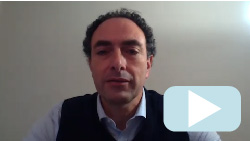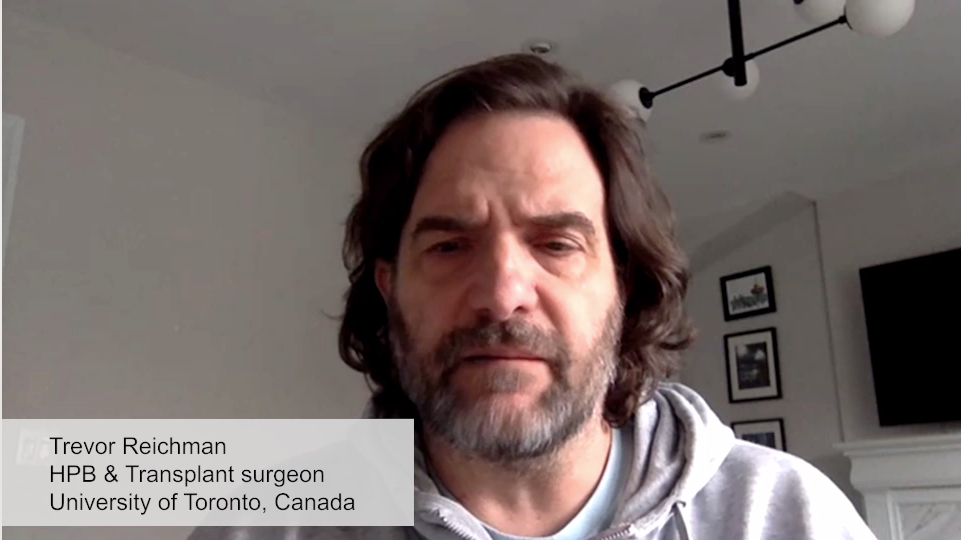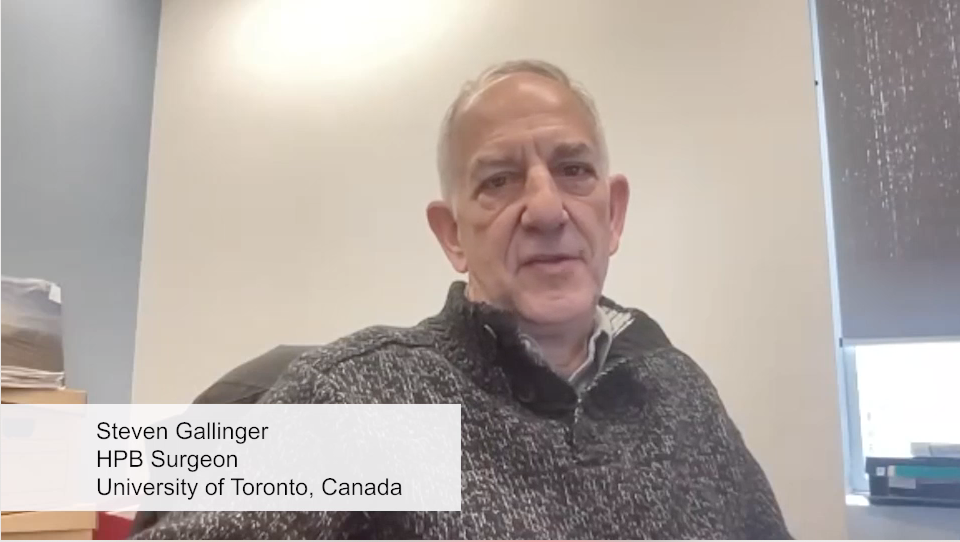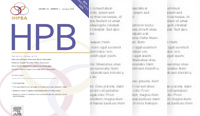International Hepato-Pancreato-Biliary Association
Vasculobiliary injury [M28]
Surgeon's Impressions
Discussions
I’m Nicolas Jarufe. I’m a Professor of Surgery and a surgeon at Clínica Las Condes in Santiago Chile and I wanted to share to you a very complex and dramatic case of a young lady with a vasculobiliary injury after cholecystectomy.
So, I said that it’s a dramatic case because it's a very young lady, is only 22 years old lady with no past medical history. [She had about two weeks history of abdominal pain and also vomiting.] And they did an abdominal ultrasound. This patient was treated in another hospital outside Santiago. The ultrasound showed an acute cholecystitis with signs of choledocholithiasis. Then they decided to go straight to an open, cholecystectomy with the bile duct exploration. [I really don't know why they decided to do this instead of doing an ERCP or a [random rules procedure], as I said before this lady was treated outside our centre so we really, really don't know a lot of information about why they did this procedure. They did straight open surgery which is not the standard nowadays.
So, what they found in the operation and important inflammatory tissue around the gallbladder. And they said that it was very difficult to identify and get exposure for all the anatomical structures. And then they got an important bleeding from the hepatoduodenal ligament. And they needed a lot of stitches, several stitches in order to stop the bleeding. And then they decided to stop the surgery and send the patient to the ICU.
So, the patient went to the intensive care after the operation and on the first day postoperative day 1, the patient was in a very bad condition with the commitment of conscience and you can see here the exams. This is only the first [day] postoperative day. For example, the white blood count was over 40,000, Bilirubin levels 18. I think the ALT and AST were nearly 5000. And an INR of 2.1. So, the patient was developing, at that time, kind of liver dysfunction. Remember this was after cholecystectomy. I mean a standard and I would say simple surgery.
So, this is CT scan done two days after the operation. This is very interesting because you will see here a huge infarction of their right lobe of the liver on this area. An ischemic area. But the left lobe was not ischemic, with perfusion. I will show you what I really want you to see, you’ll see here. This is the portal vein here, the left portal vein. You’ll see this was totally occluded after surgery. You’ll see here all of the collateral flow from the left portal vein. But the left artery is patent because this artery was coming from the gastric artery and this is an important following for the presentation. So we conclude that all the hepatic artery, the right hepatic artery was occluded. Also the right portal vein. Part of the left, this is only collateral flow. And a massive ischemic area of the right lobe, you’ll see here. So in this slide you can see how the flow in the portal vein on the left portal vein with very very low flow from collaterals, but the artery has a very good flow on the left. No artery flow on the right and the ischemic area includes almost all the right lobe.
Also on the CT scan it’s possible to see, this is an acute thrombus on the SMV; the superior mesenteric vein and portal vein. That's why I told you before that the flow on the left portal vein is only a collateral flow inside the liver. But it’s not the proper flow from the
Portal vein was totally occluded by thrombus.
So when the patient was transferred to our center, the initial CT that we saw here and due to the condition of the patient. She was doing very bad, encephalopathy and liver dysfunction. The first thing that we, the only thing at the time that we think was to do a liver transplant. Possibly total occlusion of portal vein and artery and liver dysfunction. But to do a liver transplant at least in our country is not too fast. The waiting list requires quite a long time even if we are in first place, you will find lists at days sometimes weeks. So there was an option but we didn’t know how much time it was to take. That's why we took the patient straight to the OR just to see if we could do something to stall. [But the option in a case like this, a total occlusion of the portal vein and artery plus the disruption of the right lobe, probably the best option if you have the option is a liver transplant.] Trying to avoid an emergency liver transplant, We took the patient to the OR in theatre just to explore and see what could we do to save this liver. We thought that we might take out the thrombus and restore the portal flow
So my name is Trevor Reichman and I'm a surgeon a transplant and HPB surgeon here at Toronto General Hospital. And I'm also an associate professor of surgery at the University of Toronto.
You know, based on the initial post operative day one labs and reviewing those, given the high AST, high ALT and the bilirubin and alkaline phosphatase, I would be quite concerned that there's some type of vascular injury in addition to a bile duct injury in this case. The high white (blood) count also, of course, is a concern that there's a pretty acute inflammatory process going on or a significant infection.
The fact that the patient deteriorated clinically with encephalopathy and worsening jaundice, would indicate that potentially something should be done sooner rather than later, and then given the findings of the imaging that portal flow to the liver is quite compromised, I would be inclined to operate on this patient. Especially given the fact that at this point now that it seems that she's hemodynamically stable that she would be able to survive an operation under general anesthesia and would be stable throughout it. That would be my plan, to take the patient to the operating room and explore the porta and see if we can thrombectomize and repair the portal vein to at least re-establish portal flow to the left side of the liver.
So just looking at this, it looks like there's pretty significant ischemic injury to the right side of the liver that extends basically through both the anterior and posterior segments.
And looking at the blood supply, you can see some, it looks like arterial flow on the left side of the liver which does appear to come from an accessory left coming from the left gastric.
Yeah you can clearly see that there’s a left artery that comes off of the left gastric
But the main hepatic artery, as you can see, it looks like it's out.
The portal vein, however is looks to be totally out. All the way down to basically the confluence of the SMV splenic vein, with the main portal vein being totally thrombosed and there is some flow it looks like in the left side of the liver, so there is some possibility of re-establishing flow.
OK, then let's look at the MR. The T2. Looks like a lot of fluid around the liver. So the MR is not super helpful. The ducts don't look particularly dilated, at least to my eye.
Sometimes I will get an ultrasound, a vascular ultrasound of the liver just to sort of better characterize the flow. But in this case, I think the CT is enough in this particular case. So I don't think at this point I would order any additional testing. I would just plan to explore the patient.
[Would you do anything for the biliary injury at this time?]
I think the bigger concern here is not so much the biliary system, it's more of a vascular problem. And I think that the sooner that's corrected, then the sooner you know the patient, then the liver function will get better. And then the bile duct you can either deal with at the time of the take back now, or if it's everything is still really difficult, I would just really focus on getting the portal vein open and then just draining and leaving the biliary- correcting the biliary problem at a different time.
[What are your surgical plans?]
Basically try to explore the porta and I would at least get control kind of the liver blood flow would sort of put a Pringle around probably. This way I could control blood flow if there were any issues with the portal vein. Try to dissect out and identify proximally and distally what the problem was.
I probably would not try to deal with the right side. Kind of depends on how bad the injury looked and how the liver looked. Based on the scan, the right side of the liver looks pretty ischemic so you know again my main concern would be really kind of re-establishing flow to the left side of the liver. So I would really focus on identifying the left portal vein. And then trying to do a primary repair of the left portal vein. If there wasn't enough vein left, potentially thinking about putting some sort of interposition in or Yeah, putting some type of interposition and either to the proximal portal vein or considering putting in doing some type of like a Rex shunt to establish left sided portal flow.
I don't think I would worry too much about trying to fix the artery given the fact that the left side is okay. And then if the right side really looked ischemic and the patient was doing well, I guess I would consider taking the right side, doing the right hepatectomy. But again, it would sort of depend on how things looked and how the patient was doing.
[Any concerns about future liver remnant volumes?]
It would only be a right lobe. The middle hepatic vein looks open, so it would just be a right hepatectomy and you actually could probably save a bit of the even high up, like kind of into segment 8 there's a little bit, so I think the volumes would be fine. You'd have good outflow in a 20 something year old patient. It should be fine.
[What would be the post-operative concerns?]
You know, depending on what we did. If we sort of repaired the main vein and tried to re-establish portal flow to both sides of the liver, I would be concerned a bit about whether there would be ongoing sort of injury to the right side and whether we would have to eventually go back and do a right hepatectomy.
You know, if we actually did a right hepatectomy, the concern of course would be, you know some liver insufficiency in the beginning, as the liver recovers and hypertrophies a bit. And then you know of course you know, whatever we decided to do with the bile duct, if there was some way to repair it, we would of course follow for some, you know, bile leak, I guess in the beginning. But then after that, there's always a concern down the road for stricturing or other problems related to the biliary system in the long term, which is why typically these patients need to be followed long term.
Hi, I'm Steve Gallinger. I'm a HPB surgeon at the University of Toronto and I'm one of the team members here at the HPB program at the University Health Network in Toronto.
Provided the history and the initial blood work on day, postoperative day one and four. It's a big difficult problem and my initial reaction, knowing the history and what's going on from the description, is that it's very much a case in evolution. And I wouldn't want to be too dogmatic about my approach on day four, because it'll very much depend on what happens over the next couple of days and the principles here would be to provide, obviously, intensive care support which the patient is already receiving.
So once the ABC's were dealt with and I'm assuming they've been dealt with in the ICU, we're looking at a life threatening liver problem. Mostly liver failure related to the vascular injuries to the hepatic arteries. Maybe the portal vein as well? Although this could be from the repair that was described due to the bleeding. And the bile duct injury per se is actually less important right now, but we want to make sure that if there was an open bile duct, that it is being adequately drained, in this case percutaneously if drains were not left in during the OR, but I haven't got to that point yet.
[Findings] (1:49 [109])
So looking at the imaging, which I presume is around day four, the right lobe is ischemic or infarcted? It's hard to say definitively that nothing will recover on the right side, but the patient is lucky and to some degree because she's healthy and young and has a good size left lobe. Although the left lobe apparently doesn't have good blood supply either.
The accessory left artery off the left gastric is critical for her. That may be all she has to her left lobe. I'm glad she has it. Without that, it could be even worse. That might be keeping part of her liver, her left lobe, alive and it's good. I mean, I guess we could assume that the right lobe is dead and is not going to recover. Maybe small patches could recover through intrahepatic collaterals, even. But the left lobe doesn't look too bad, and certainly it's big enough to you know, to maintain life, if the function improves and again the function improving will be dependent on the vasculature. It's hard to live on an artery only with no portal vein, but it can happen, and over time she may develop collaterals and the portal vein might open up, although we're not really sure what's happened other than this bleeding that was repaired in the OR and I don't know if it was a hole or in the end they actually tied off or damaged the entire portal vein system. It's really hard to know at this point. It looks pretty bad from the CT scan.
[What are your plans?] (3:20 [200])
This is very much a case in evolution. I don't know if I would jump to any specific maneuvers at this point other than perhaps anti-coagulating? I don't think that we could intervene successfully, although it would be nice to open up the portal vein if possible. But I have a feeling it can't be open. So unfortunately for this patient, she's relying on very limited blood flow to her liver, arterial and venous, and time will tell over the next day or two what transpires. She could gradually improve over a very long period of time with the development of collaterals, but I wouldn't jump in to resect the right lobe, although it's certainly a source of infection as well as other cytokines released by an ischemic- acutely ischemic liver, so again, as I mentioned before, a lot of this would be supportive in nature over the next 24 to 36 hours and see how it evolves. But I wouldn't necessarily have any major interventions at the moment because there isn't too much you can do other than taking out the right lobe, which would be pretty morbid and dangerous. Trying to open up the portal vein maybe as a last ditch attempt, but today I probably wouldn't do anything different than what's being done as long as the bile duct is being adequately drained and I see a big drain coming around the right side into the lesser sac, so I'm okay for the moment with presumably a high level support in the ICU.
[What signs of improvement would you look for?] (5:04 [304])
Cardiovascular parameters. I don't know if she's on inotropes, but you know, a reduction in inotropes, level of consciousness, the usual vital signs: cardiovascular support improving, respiratory support improving, sepsis with blood work, lactate would be quite helpful. So serum lactate and transaminases as well as the INR. So it's kind of the whole constellation of liver support and you can tell with the blood work over the next I would say 12 to 18 to 24 hours, which way this is going and if there's any acute intervention. Obviously in the long term the question of, or not necessarily long-term but medium term, is whether a liver transplant will be necessary to save her life.
[What surgical options could be considered?] (6:01 [361])
An acutely infarcted right lobe can be managed conservatively without jumping to removing it. There is a temptation to remove the right lobe. But I don't think it's absolutely necessary and it's a big operation in someone who's already pretty quite sick. I don't think that the arteries can be repaired to any degree where blood flow would be restored, so I think the arteries are done. The portal vein, you could consider trying to revascularize, but again, at four days or maybe five days, the clots probably really well established and perhaps it could be explored. I wouldn't personally jump in and do anything surgical at the moment. I would like to see what happens over the next day or two.
[What might you consider if exploring the bile duct injury?] (6:51 [411])
The nature of the injury, it might be a mess because it's day four, it's getting a bit on in time but can I see the bifurcation? Can I see the common hepatic duct? Where is the injury? Is it low, down, high up? Are we dealing with one, one open duct or multiple? But at this point I don't. There's certainly no consideration of a reconstruction, but you might see grossly. You might obtain some information grossly that you can't see any other way.
[What factors affected your decision to wait?] (7:26 [446])
The transaminases dropped a lot over the ensuing first three days, and the INR in particular dropped to 1.7. Now I don't know if the patient received plasma, which could falsely correct the INR. But in patients with major liver resections, I find the INR is very valuable in monitoring the function of the remaining liver and it's very useful and a value under 2 on Day 4, I would say is a good sign, so I don't know if I would jump to do any intervention, although I wouldn't be critical of somebody looking at the portal vein. Although I don't know if the flow could be restored. I mentioned the idea of a liver transplant as the salvage last ditch life saving maneuver which has to be kept in mind, but I'd be curious what happened over the next few days before deciding on any surgery at all.
Although it's a bit of a catch 22 because if she's deteriorating from liver failure, then you won't get a handle on anything which is the trigger to do something. So as I mentioned from day one to four, now we don't know if the deterioration was related to lack of appropriate support in a center that doesn't have the resources or the patient was truly deteriorating. So as I said at the beginning, this is very much in evolution and I would like to know what happens over the next 12 to 24 hours once she is in our center receiving what we think is the best care so it's a little bit of a wishy washy answer because I think at this point there's too many variables that are not consistently getting better or worse. I’d want to see what happens myself over the next day or two before jumping into an operation or any other major intervention.
Acknowledgements
Thank you to the HPB Surgeons who contribute their time and expertise. This content is made possible through educational grants from:
Case 28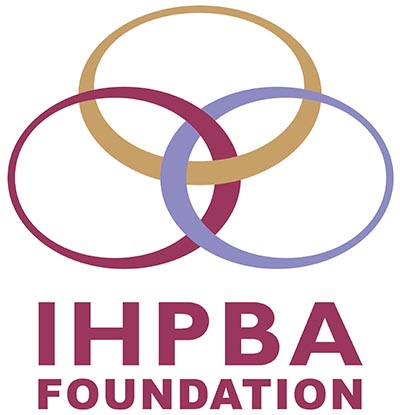

Views and opinions expressed in all videos and module content are those of the individual surgeon and solely intended for surgical education purposes. We do not endorse any product, treatment or therapy.
Corporate Partners
If you are interested in becoming a Corporate Partner of the IHBPA please contact industry@ihpba.org
Find out more
 Go to myHPB
Go to myHPB
